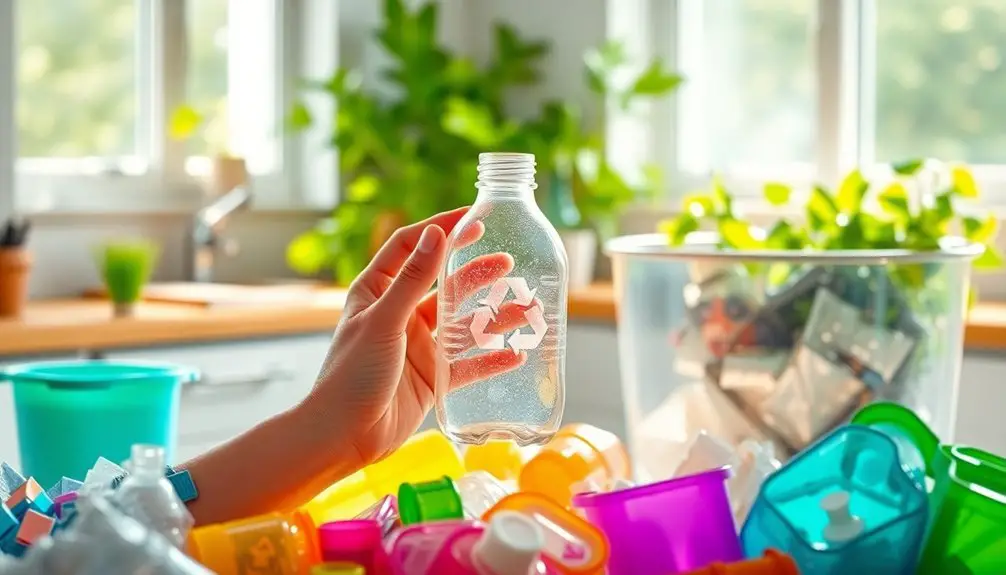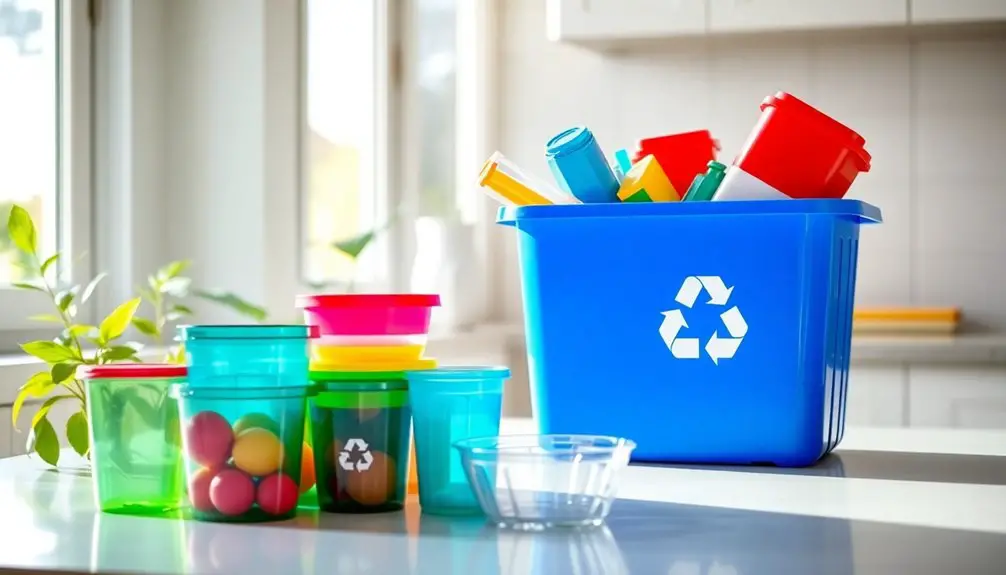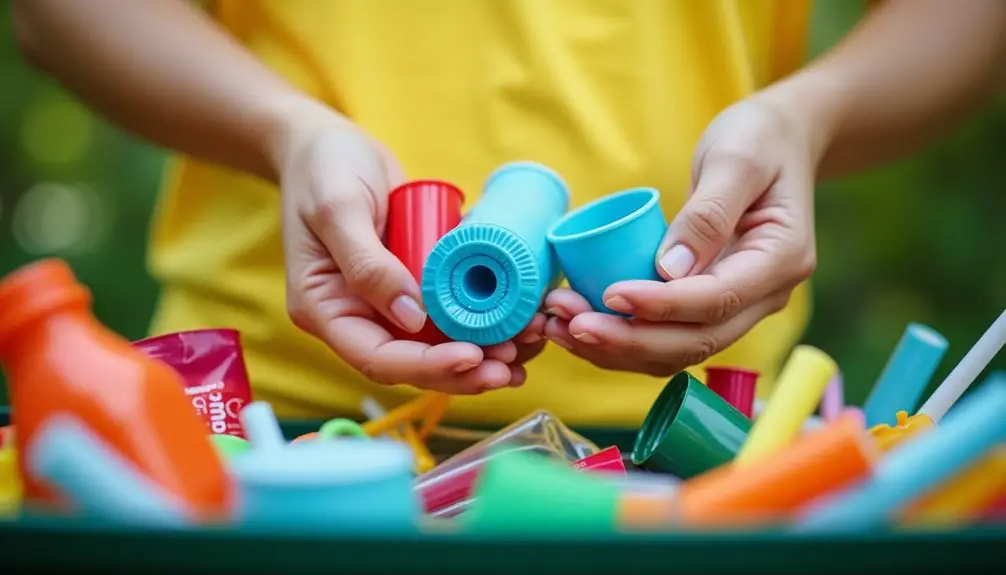To recycle polypropylene, start by checking your local recycling guidelines. Look for the recycling symbol ♷ and the number 5. Clean and sort your polypropylene items, such as yogurt containers or medicine bottles, to remove any contamination. Place them in designated recycling bins or take them to local recycling centers. If your area doesn't accept polypropylene curbside, explore specialized programs like Preserve's Gimme5. Remember, recycling helps reduce waste and supports a sustainable economy. Stick around to discover more about the recycling process and the innovative products made from recycled polypropylene.
Key Takeaways
- Identify polypropylene items using the recycling symbol ♷ and code 5, such as yogurt containers and medicine bottles.
- Clean and sort polypropylene products to remove contaminants before recycling; ensure they are free from food residue.
- Place accepted polypropylene items in designated recycling containers or check local curbside programs for guidelines.
- Locate nearby recycling centers using resources like Earth911, ensuring they accept polypropylene materials.
- Participate in specialized recycling programs, such as Preserve's Gimme5, for hard-to-recycle polypropylene items.
Understanding Polypropylene Recycling
When it comes to recycling polypropylene, understanding its unique challenges is essential. Polypropylene, identified by the recycling symbol ♷ and code 5, is commonly found in household products like yogurt containers and medicine bottles.
Despite being a recyclable material, only about 1% of polypropylene gets recycled. Most of it ends up in landfills, where it can take 20-30 years to decompose, causing significant environmental concerns.
The recycling process for polypropylene involves several stages, starting with collection and sorting. However, not all polypropylene products are recyclable due to design and contamination issues.
Contaminated materials can hinder the recycling process, making it crucial to use proper recycling facilities that specialize in handling polypropylene. By ensuring that you clean and sort your recyclable materials, you can contribute significantly to the recycling efforts.
Additionally, proper sorting of polypropylene products plastic recycling codes is vital to the recycling process.
You can also locate local recycling options through resources like Earth911 or participate in programs like Preserve's Gimme5.
The Recycling Process Explained
It all starts with collection, where you deposit your polypropylene (PP) plastic items in designated recycling containers. Waste management services then gather these containers for processing.
Next is the sorting process, where advanced techniques like optical sorting and manual picking come into play. These methods help separate PP from other plastics and contaminants, ensuring that only the right materials move forward.
After sorting, the PP plastic undergoes cleaning to remove impurities, making it ready for the next steps.
Once cleaned, the PP is shredded into smaller pieces. This shredded material is then heated and melted, turning it into pellets.
These pellets are crucial for the final step, known as compounding, where they can be molded into new products, effectively closing the recycling loop.
Keep in mind that not all PP products are accepted in standard recycling programs. You should always check your local recycling guidelines to ensure proper disposal of your polypropylene items.
The environmental benefits of recycling polypropylene are significant, saving up to 80% energy compared to producing new polypropylene, thereby reducing greenhouse gas emissions.
Benefits of Recycling Polypropylene

Understanding the recycling process highlights the numerous benefits of recycling polypropylene. By actively participating in this initiative, you can help reduce landfill waste, as polypropylene takes 20-30 years to decompose. This effort extends landfill life and minimizes environmental pollution. Additionally, recycling polypropylene through programs like TerraCycle Zero Waste Box can provide an alternative solution for hard-to-recycle materials. Recycling polypropylene conserves resources by reusing existing materials, which decreases the need for virgin material extraction. This not only positively impacts greenhouse gas emissions but also supports biodiversity. Each ton of recycled plastic saves around 5,774 kWh of energy, showcasing significant energy conservation.
Here's a quick breakdown of the benefits:
| Benefit | Explanation |
|---|---|
| Reduces Landfill Waste | Less waste means longer landfill life. |
| Conserves Resources | Reuses materials, decreasing virgin extraction. |
| Energy Conservation | Saves approximately 5,774 kWh of energy per ton. |
| Job Creation | Supports local manufacturing within the circular economy. |
Engaging in recycling polypropylene also fosters innovation in new plastic products made from recycled materials, driving economic benefits and creating new job opportunities. Your participation can make a substantial difference!
Common Recycled Polypropylene Products
A wide range of products can be made from recycled polypropylene, demonstrating its remarkable versatility across various industries.
In your everyday life, you might encounter common recycled products like outdoor rugs and storage containers, all crafted from this durable material. The construction industry also benefits from recycled polypropylene, using it in plastic lumber and insulation materials to support sustainable building practices. Additionally, companies like Polywood utilize recycled HDPE in their production processes, reducing waste and conserving resources in the creation of eco-friendly furniture.
In the automotive sector, you'll find recycled PP in various components, including car seats and dashboards, showcasing its adaptability in high-performance applications.
If you're interested in sustainable fashion, consider that this material can be transformed into fibers for clothing and textiles, helping to reduce textile waste while making stylish garments.
Recycled polypropylene even finds its way into household products, with items like kitchen utensils, paint cans, and packing peanuts made from this versatile plastic.
By choosing products crafted from recycled polypropylene, you're contributing to a more sustainable future while benefiting from the durability and functionality these items offer.
Embrace the versatility of recycled polypropylene, and support the circular economy through your purchasing decisions.
Resources for Proper Recycling

To effectively recycle polypropylene, tap into various resources that can guide you through the process. Start by checking municipal recycling guides to see if your area includes polypropylene in its curbside collection program. Many municipalities don't accept PP, so knowing the rules is crucial for proper disposal.
Next, utilize platforms like Earth911 to locate local recycling centers that accept polypropylene. These centers provide valuable guidance on how to recycle PP effectively. Familiarize yourself with the recycling symbol for polypropylene—look for the number 5 inside a triangle—to ensure you're sorting and disposing of these products correctly.
If your local options are limited, consider participating in specialized recycling programs like Preserve's Gimme5, which allows you to mail in certain PP items that aren't accepted nearby.
Additionally, collaborate with local businesses and community programs that focus on collecting and recycling polypropylene waste. These initiatives not only enhance recycling efforts but also foster community involvement. Furthermore, understanding the plastic contamination rates and their impact on recycling centers can help you better prepare and sort your materials for effective recycling.
Frequently Asked Questions
What Is the Process of Recycling Polypropylene?
Recycling polypropylene involves collecting your items, sorting them from other plastics, cleaning, shredding into smaller pieces, melting, and forming pellets. These pellets are then used to create new products, completing the recycling process.
How Do You Dispose of Polypropylene?
To dispose of polypropylene, check local recycling guidelines first. Clean your PP items, removing any residues. If curbside isn't an option, seek specialized recyclers or participate in retailer-specific programs for better disposal solutions.
Is Polypropylene Recyclable in the US?
Yes, polypropylene is recyclable in the U.S., but it's not widely accepted in local recycling programs. You'll need to find specialized facilities that accept it. Check resources like Earth911 to locate nearby recyclers.
Can You Put PP in a Recycling Bin?
You can put polypropylene in a recycling bin, but first, check your local guidelines. Some curbside programs don't accept it, so ensure it's clean and properly sorted to increase its chances of being recycled.

